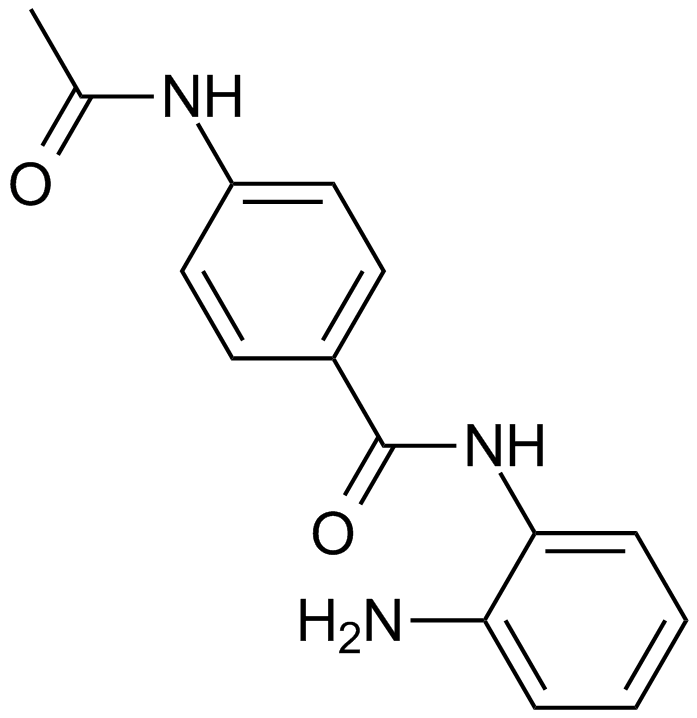CI994 (Tacedinaline) (Synonyms: N-Acetyldinaline, Goe 5549, PD 123654, Tacedinaline) |
| Catalog No.GC13408 |
An inhibitor of HDAC1, -2, and -3
Products are for research use only. Not for human use. We do not sell to patients.

Cas No.: 112522-64-2
Sample solution is provided at 25 µL, 10mM.
CI994 is a selective inhibitor of HDAC1 with IC50 value of 0.57 μM [1].
HDAC1 is an enzyme that encoded by HDAC1 and plays a pivotal role in regulating eukaryotic gene expression. It is also been reported that HDAC1 interacts with retinoblastoma tumor-suppressor protein which is a key element in the control of cell proliferation and differentiation. Many studies have shown that HDAC1 inhibition works as a promising therapy used for cancer treatment in clinic [2] [3].
CI994 is a selective HDAC1 and HDAC3 and is different from the reported unselective inhibitor SAHA. When tested with HeLa cervical carcinoma cells, CI994 treatment showed a selectivity inhibitory ability for HDAC1 and 3 with the IC50 was 43.5±1.2 μM [4]. In peripheral blood lymphocytes isolated from untreated male Wistar rats, administration of CI994 for 24 hours induced cells apoptosis in a dose-dependent manner (1 μM~10μM ) [1]. When tested with mitogen-stimulated blood lymphocytes, CI-994 treatment inhibited cells proliferation with IC50 value of 3 mM [5]. In NSCLC cell lines (A549 and LX-1), CI994 administration induced cell apoptosis via inhibiting HDAC activity and arresting cell cycle at G0/G1 phase and showed a promising therapy strategy when combined with chemotherapy [2].
In male rats model, oral administration of CI994 markedly effected lymphoid tissue via reducing blood lymphocytes, monocytes, neutrophils and bone marrow lymphoid cells at the concentration of 10, 23, and 45 mg/kg on day 1 and/or 3 [5].
References:
[1]. Graziano, M.J., et al., Induction of Apoptosis in Rat Peripheral Blood Lymphocytes by the Anticancer Drug CI-994 (Acetyldinaline)(*). J Biomed Biotechnol, 2001. 1(2): p. 52-61.
[2]. Loprevite, M., et al., In vitro study of CI-994, a histone deacetylase inhibitor, in non-small cell lung cancer cell lines. Oncol Res, 2005. 15(1): p. 39-48.
[3]. Cacan, E., et al., Inhibition of HDAC1 and DNMT1 modulate RGS10 expression and decrease ovarian cancer chemoresistance. PLoS One, 2014. 9(1): p. e87455.
[4]. Beckers, T., et al., Distinct pharmacological properties of second generation HDAC inhibitors with the benzamide or hydroxamate head group. Int J Cancer, 2007. 121(5): p. 1138-48.
[5]. Graziano, M.J., A.J. Galati, and K.M. Walsh, Immunotoxicity of the anticancer drug CI-994 in rats: effects on lymphoid tissue. Arch Toxicol, 1999. 73(3): p. 168-74.
Average Rating: 5 (Based on Reviews and 30 reference(s) in Google Scholar.)
GLPBIO products are for RESEARCH USE ONLY. Please make sure your review or question is research based.
Required fields are marked with *




















